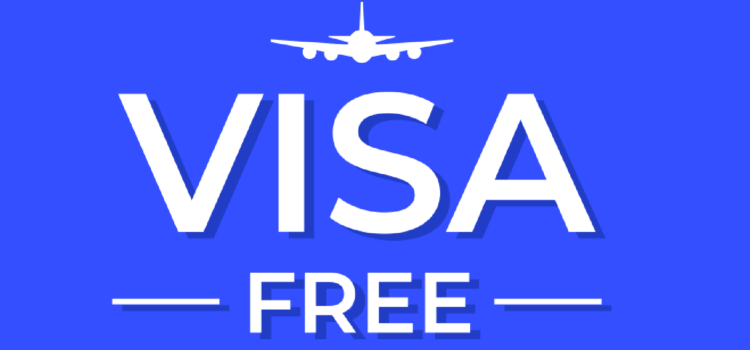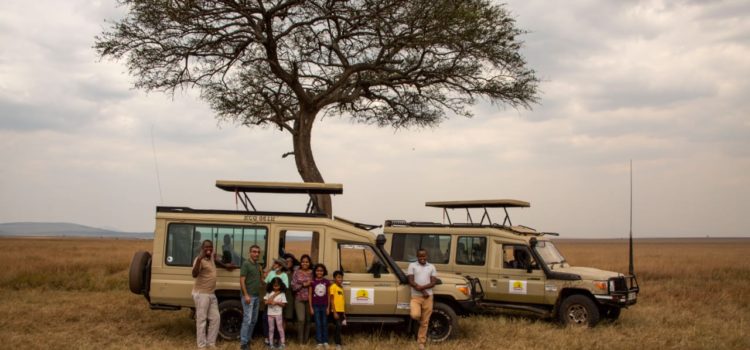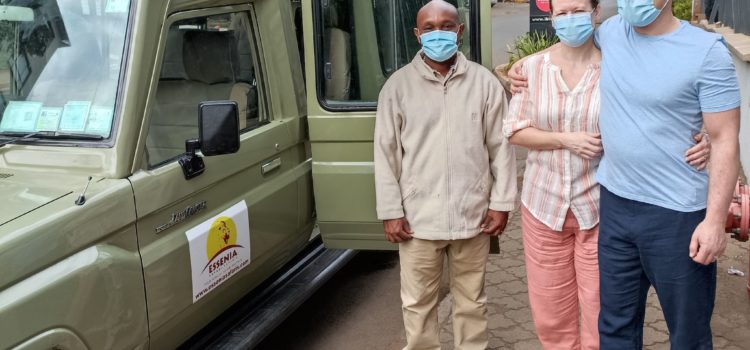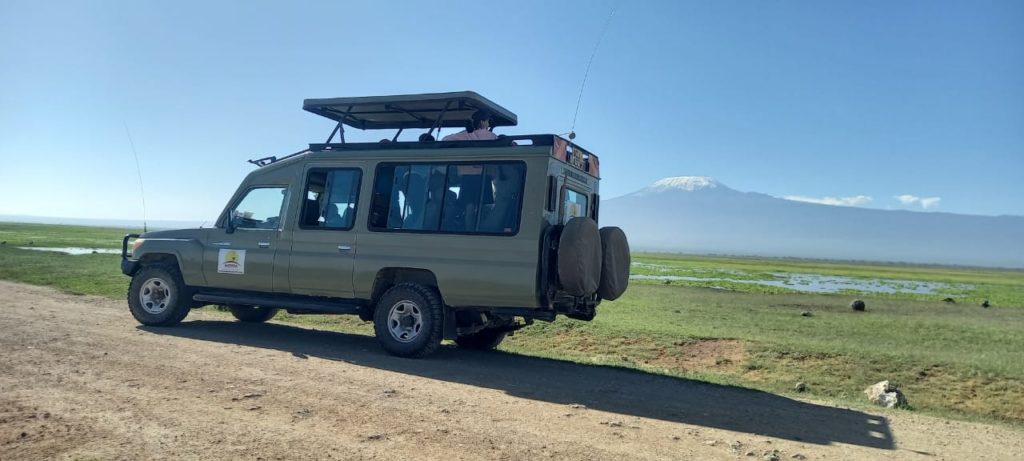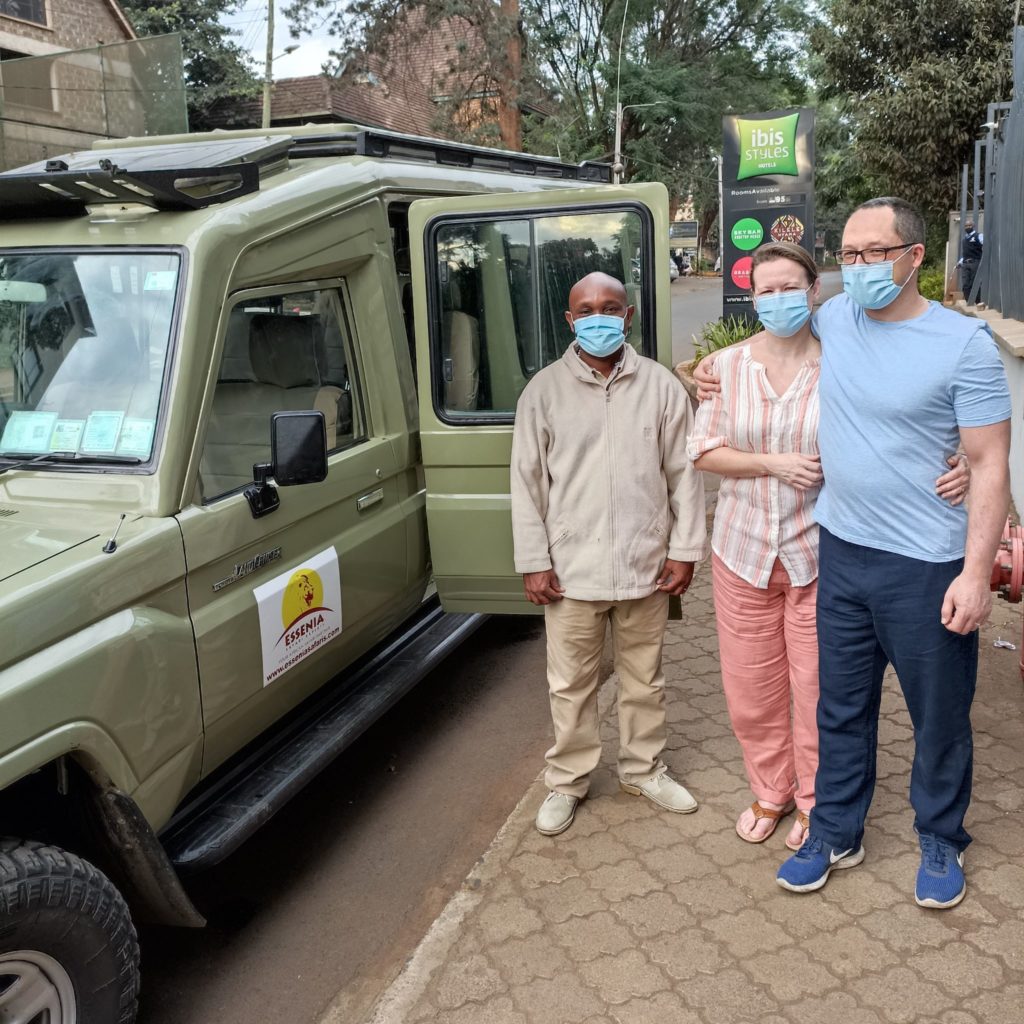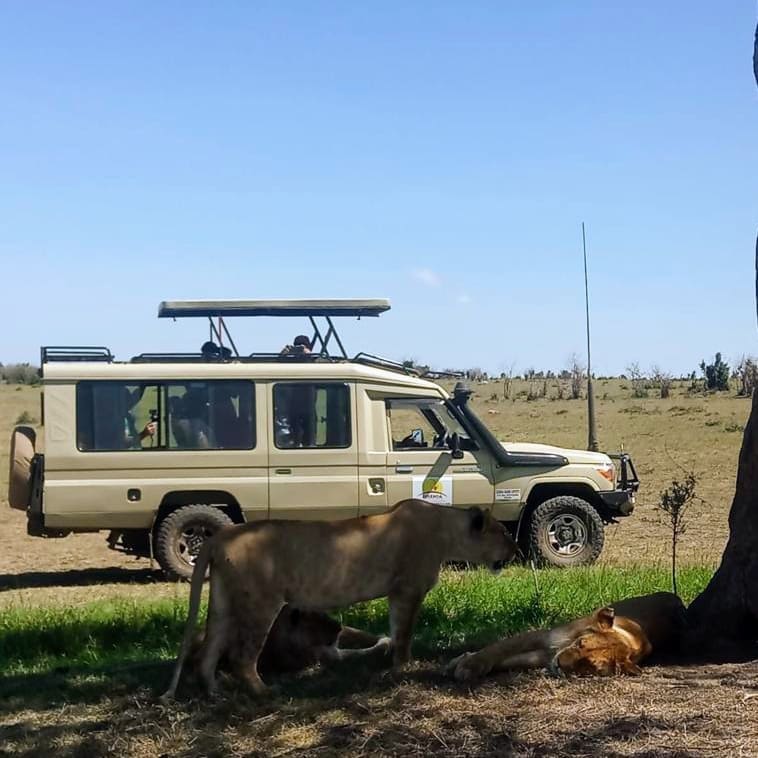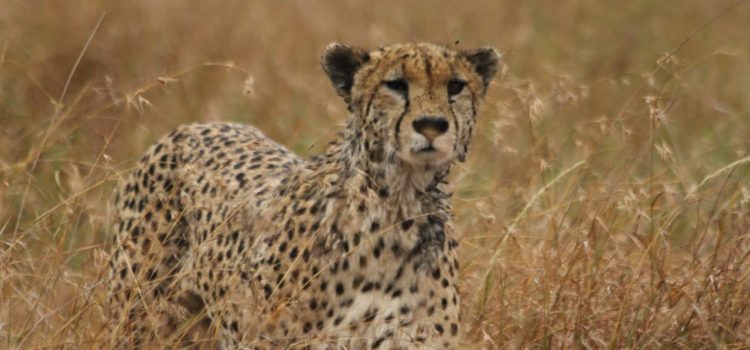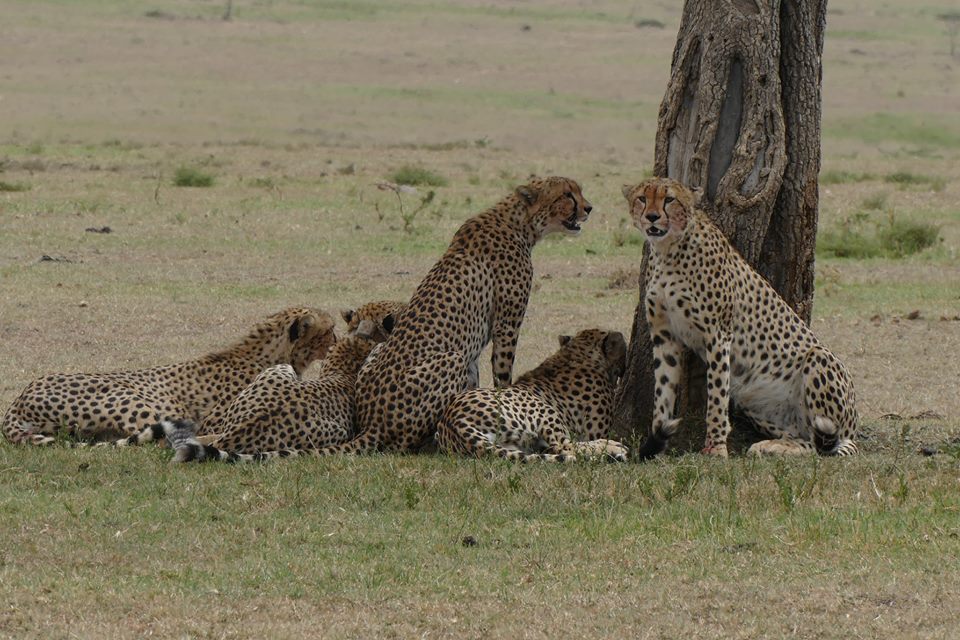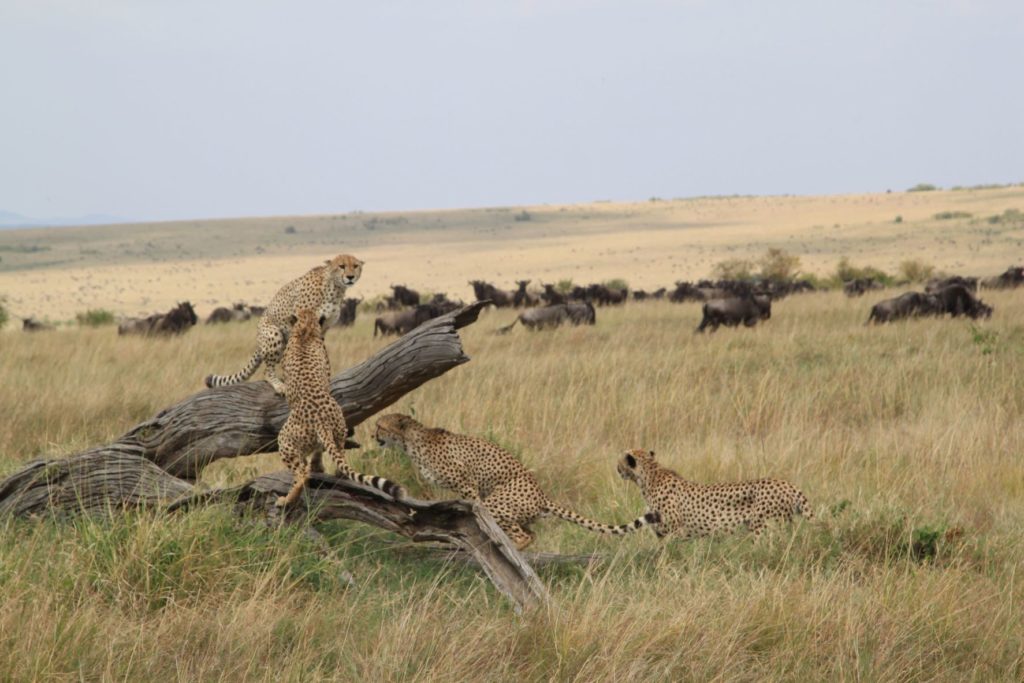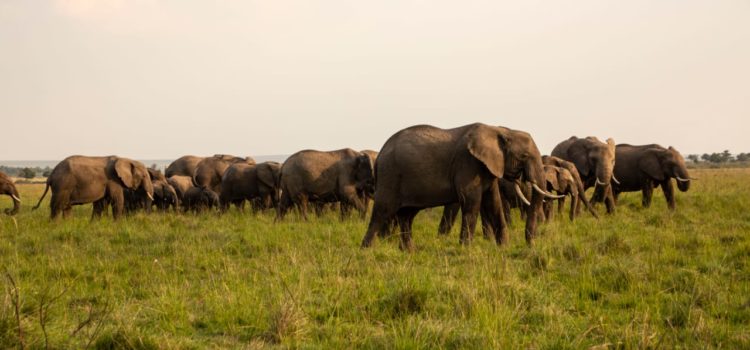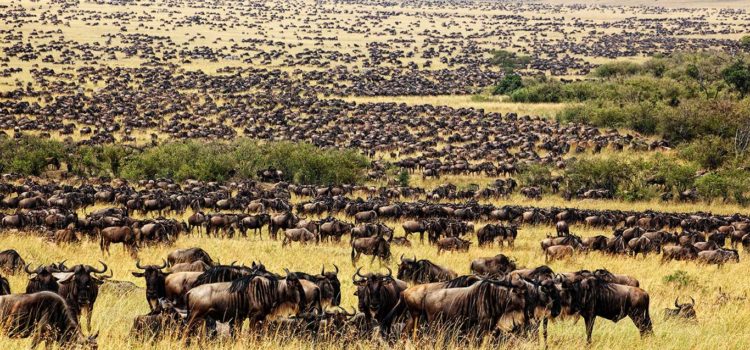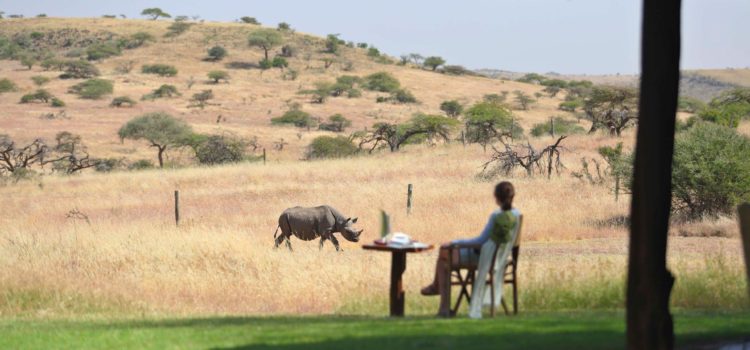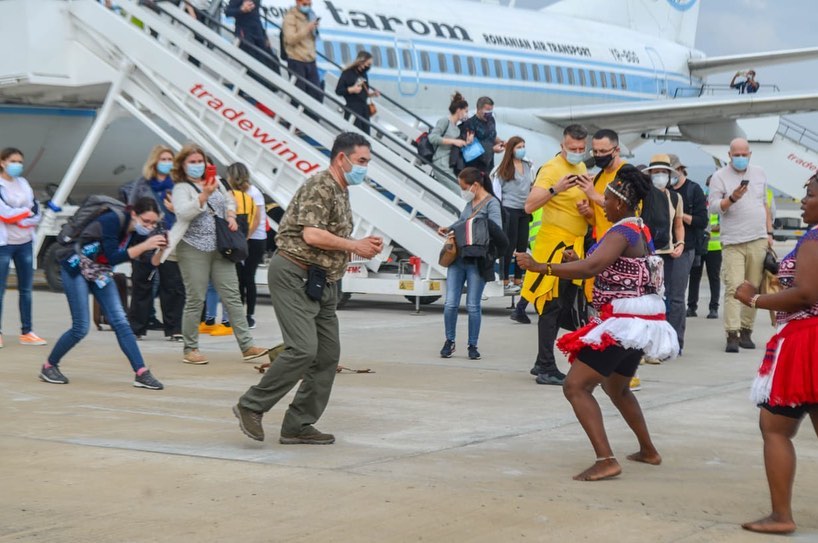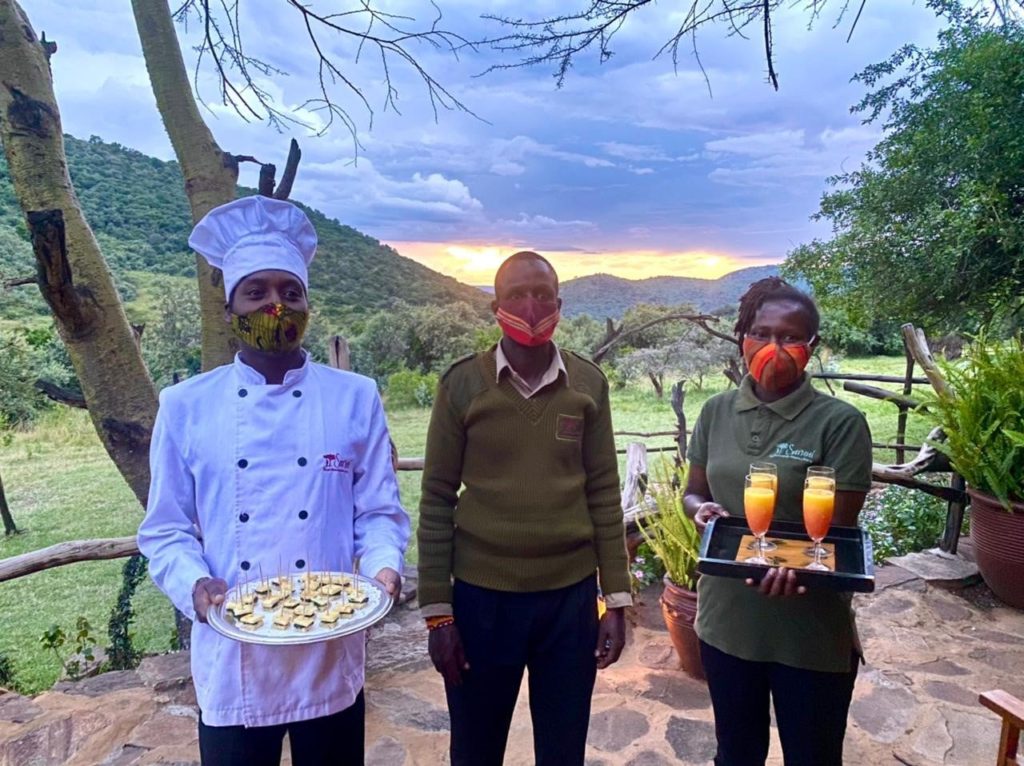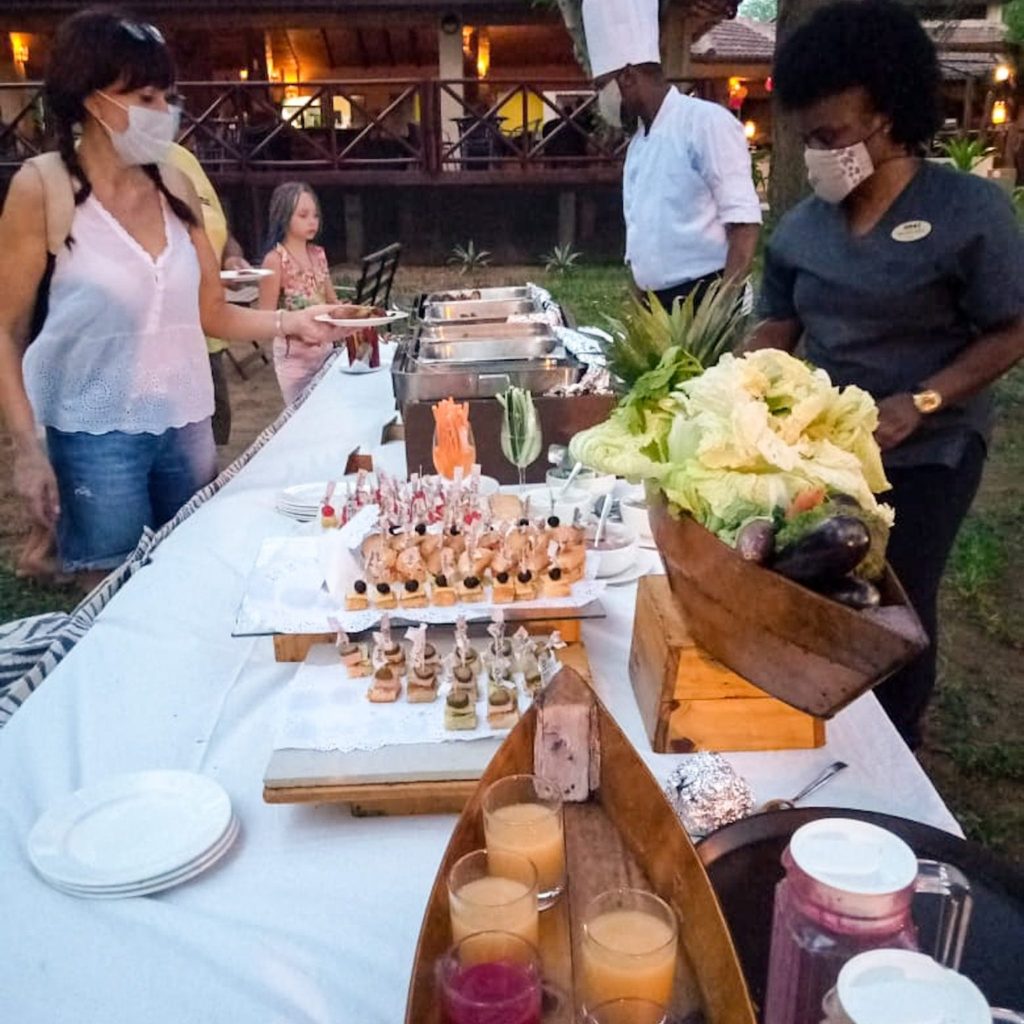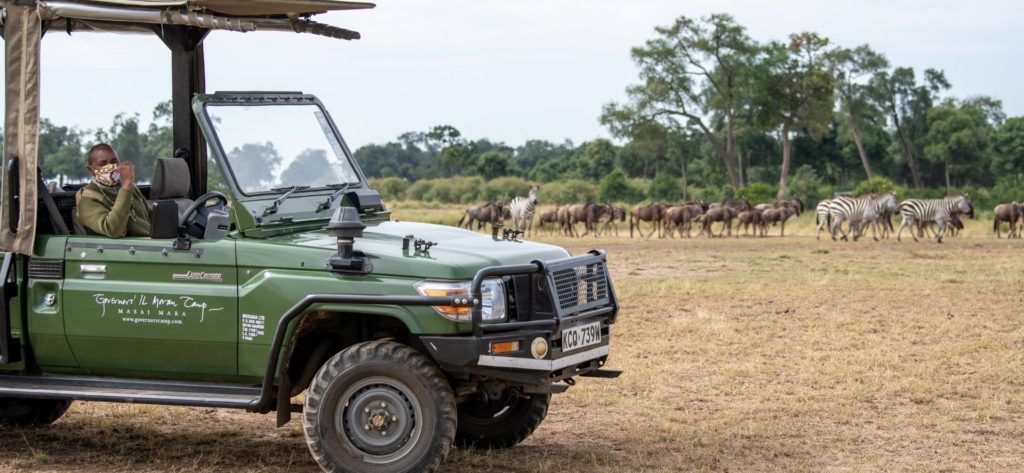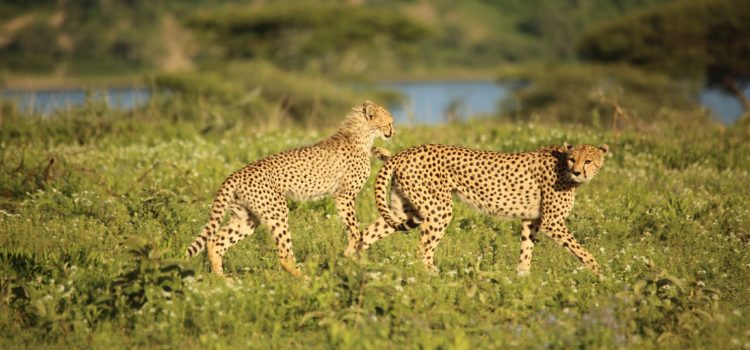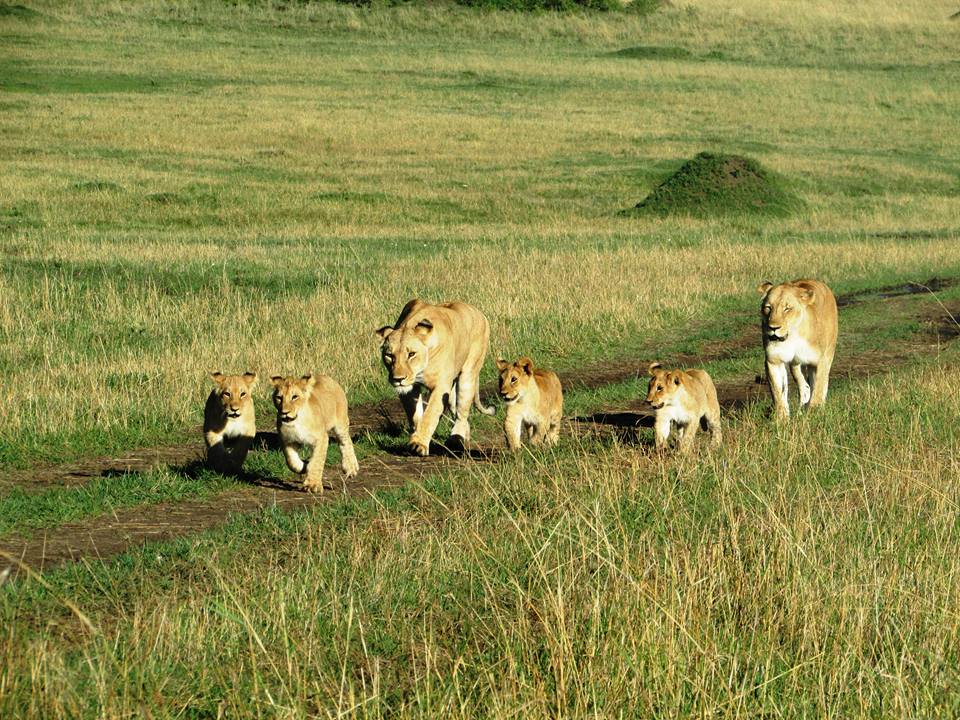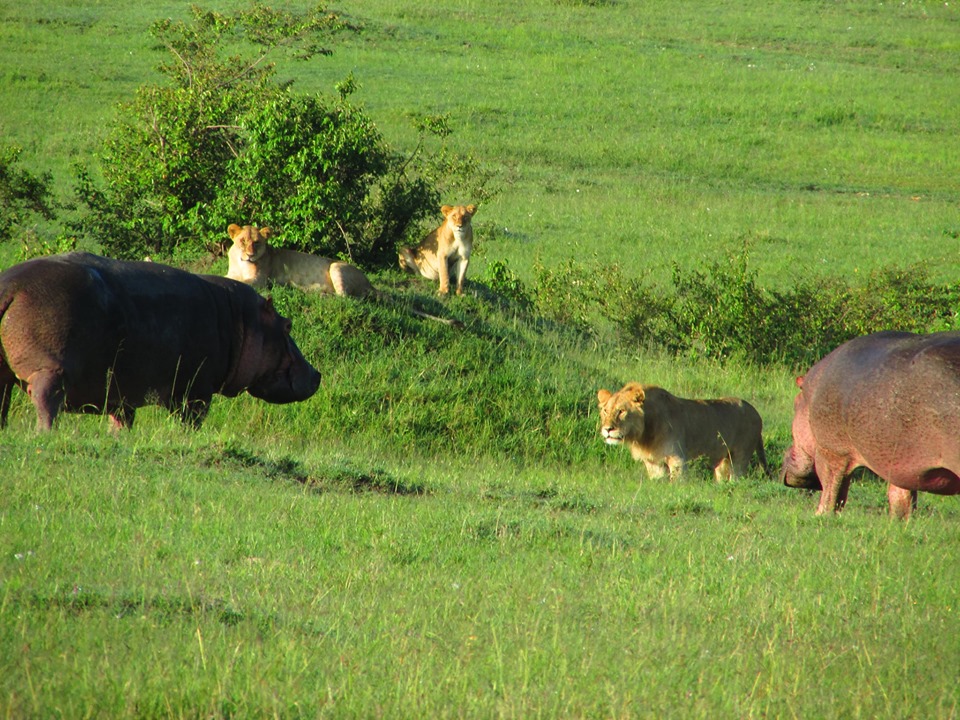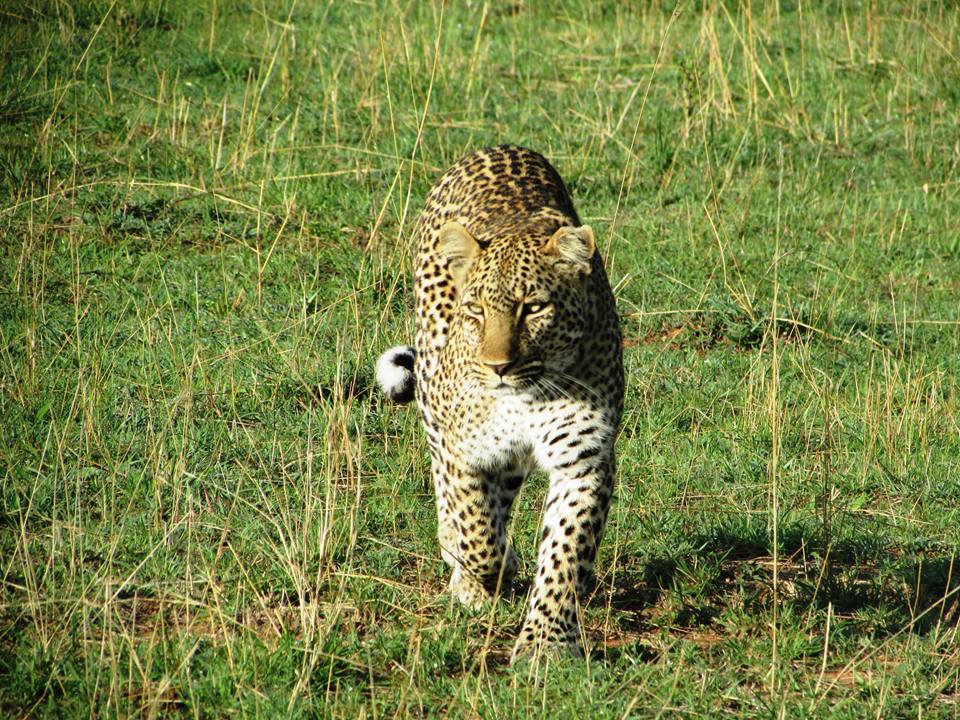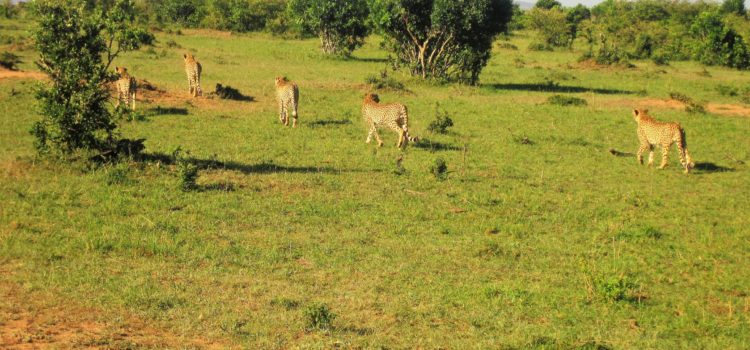Kenya Visa requirements 2024; is entrance to Kenya visa free?
Kenya Visa requirements 2024; is entrance to Kenya visa free?
From 4th January 2024, all travelers to Kenya will no longer need a visa to enter the country which is famous for its vibrant city of Nairobi, leading national parks for safaris and amazing beaches.
Instead, travelers to Kenya will now need to apply for Electronic Travel Authorization (eTA) which must be applied for before departure from your country on the following link: https://www.etakenya.go.ke/en
This announcement was made by the Kenya Civil Aviation Authority in a notice to all airmen (NOTAM) dated 4th January 2024. The eTA which costs USD 30 per person replaces the previous requirement for a Visa which was costing USD 50 per person. Citizens of the East Africa Community member states; Tanzania, Uganda, Rwanda, Burundi, South Sudan and the DRC are exempted from applying for the eTA.
An application for the eTA will according to the KCAA NOTAM takes between 24 and 72 hours to be approved but citizens from category 3 countries (those that required referral visa) might have to wait longer.
Eligibility for Kenya’s Electronic Travel Authorization
Each eligible traveller is required to apply for an eTA before starting the Journey to Kenya. It is mandatory to use the Government’s official website to submit an application. Applications submitted via third party websites will be automatically rejected. For minors (children under the age of 18), the legal guardian, parent or accompanying adult is responsible for filling the application.
Requirements for Application of Kenya’s Electronic Travel Authorization
- Valid passport (must have a validity period of more than 6 months and have at least one blank page)
- Recent passport picture OR a selfie picture taken during application process
- Contact details (home address, telephone, email)
- Travel information and flight itinerary (arrival flight number, date of departure of initial flight in case of connecting flights)
- Proof of booking for the hotel you will be staying at (if staying with friends, a letter of invitation is accepted)
- Yellow fever vaccination certificate if coming from endemic countries (please check the WHO website for the updated list of countries)
- Credit/Debit card information for payment, if applicable
WELCOME TO MAGICAL KENYA AND FEEL FREE TO ENQUIRE OR BOOK A SAFARI WITH US.
Melia Lodge Ngorongoro set to start welcoming guests on 1st July 2023
The management of Melia collection have announced that Ngorongoro Lodge, a new lodge under the Melia collection portfolio will start welcoming guests on 1st July 2023.
It is located in the largest volcanic caldera in the world, with views of the Ngorongoro Crater.
This will make it the fourth Melia collection property in Tanzania after Melia Zanzibar, Melia Serengeti Lodge and Gran Melia Arusha which have already been operational for a couple of years.
Located in the Ngorongoro Conservation Area, the luxury lodge which is perched on the rim of the Ngorongoro Crater comprises of 56 rooms, all with great views to the crater below. It is worth noting that the Ngorongoro Crater is the largest caldera in the world. 34 of the rooms at the lodge are standard category, together with 24 suites and 1 villa. The lodge will also offer a wide leisure experience with two restaurants, one grill zone, an outdoor infinity pool, spa and much more.
The Ngorongoro Conservation Area which hosts Melia Ngorongoro Lodge is home to an ecosystem that is unlike any other in Tanzania. Designed with the utmost respect for the environment, this lodge allows you to sleep accompanied by the sounds of nature, wake up admiring the Ngorongoro Crater, and enjoy a truly extraordinary safari experience.
The 600-metre-deep crater is home to more than 25,000 animals and boasts of over 2.5 million years of history. These are just but some of the treasures awaiting you in this “Garden of Eden”. Ngorongoro Lodge Meliá Collection is fully integrated with the local biodiversity, home to the Maasai, one of the largest tribes in the country. While staying here, you can relax in the infinity pool and exclusive spa, and savour dining experiences with strong local roots.
The lodge boasts of a unique location, among the few lodges that overlook the crater rim. The Ngorongoro Crater, is a breath-taking 8.000-meter square natural oasis due to its stunning biodiversity, with more than 20,000 herbivorous mammals and a big concentration of major predators on earth, all of which play a fundamental role in maintaining the ecological balance.
Melia Ngorongoro Lodge is part of a select collection of lodges in the so-called “Crater highlands” area in the Arusha region in northern Tanzania. It is a 180 kilometers drive from the city of Arusha and a 220 kilometers drive from the Kilimanjaro International Airport. The distance from Manyara airport to Melia Ngorongoro Lodge is 41 kilometers.
It is also possible to drive from the lodge to Serengeti when on one of our Tanzania safaris, on a drive that takes 4 to 5 hours.
When fully operational, the room configuration at Melia Lodge Ngorongoro will be as below:
The Forest Premier Room- 22
Inter Connected, The Forest Premier Room- 11
The RING premier room- 12
Enkanji junior Suite- 17
Emuny Suite with terrace- 1
Sidai Suite- 1
Superior Suite with terrace- 1
Superior Suite with terrace (2 bedrooms)- 1
Grand Suite with private pool- 1
Grand Suite with private pool (2 bedrooms) – 1
Ngorongoro House with private pool – 1
Every unit has a private bathroom and shower, air conditioning, a flat-screen TV and a minibar.
What are the Covid 19 entry requirements to Kenya and Tanzania in 2022?
With Covid 19 infection rates having been recorded to have significantly reduced by end of February 2022, the world seems to have turned yet another corner when it comes to tackling the pandemic, and we can only hope that there will be no more outbreaks.
UPDATE ON KENYA: Please note that effective 11th March 2022, all travelers to Kenya who are fully vaccinated will no longer be required to present a Negative PCR test certificate on arrival. https://www.kcaa.or.ke/covid-19/covid-19-travel-requirements They are however still required to upload their vaccination details on the Global Haven website before boarding their flight and also fill the traveler health surveillance form. This is because there will be no manual validation of vaccination details, only online.
Planning to travel to Kenya in 2022? These are the current Covid 19 requirements.
First of all, all travelers to Kenya aged 18 years and above must provide a Covid 19 vaccination certificate at the point of entry. The vaccine administered must be among the ones already approved by the World Health Organization. This requirement has been in place since December 2021. The only travelers exempted from this requirement are returning Kenyans. They must however register themselves on the Ministry of Heath Vaccination portal and will be vaccinated upon arrival at the airport, before they are allowed to head home.
All travelers arriving in Kenya are supposed to present a Negative Covid 19 PCR test certificate at the point of arrival. The certificate must be valid for not more than 72 hrs since the test was taken. Travelers are also required to fill in the Ministry of Health’s travelers’ surveillance form at https://ears.health.go.ke/airline_registration/ before boarding their last flight to Kenya.
After receiving a negative PCR test result, travelers to Kenya are required to register and upload their vaccination and test result for validation at the global heaven website before boarding their flight to Kenya.
Children aged below 5 years are exempted from the three requirements above.
To depart Kenya, all travelers travelling to a destination / country that requires prove of a Negative Covid 19 test must show proof of the same at the point of exit of having met that condition, before being allowed to depart Kenya.
There are several clinics and hospitals in Kenya that have been approved by the Kenya Civil Aviation Authority to administer PCR tests in Nairobi and others cities. In Nairobi, Covid 19 testing prices range from USD 50 to USD 100 depending on the facility where the test is taken. Results are ready after between 6 and 24 hrs, depending on the facility where the test is taken, and the price paid as some clinics can issue results within 3 hrs but at a higher cost.
If you are on safari in Amboseli, Lake Nakuru National Park, Masai Mara National Reserve and other parks within Kenya and will need a PCR certificate before departing in Kenya, we can facilitate for a test to be done at your lodge. This however costs more due to logistical challenges by the testing labs which are mainly based in Nairobi. The current cost of a PCR test in Amboseli and Masai Mara is about USD 120 per person (based on minimum 2 people) while it costs about USD 100 while at Lake Nakuru. Results are ready after 24 hrs so you need to ensure that you register to get your sample collected at least a day before.
While traveling in Kenya, standard Covid-19 protocols (masking, social distancing, and sanitizing) will be adhered to by your guide and those working in the tourism industry, while in public settings, airports/airplanes, and the common areas of accommodations. All full time Essenia Safari Experts guides have been fully vaccinated against Covid-19.
Much of your time while on safari will be socially distanced from other travelers and the general public.
Please note that social distancing and wearing of face masks is a mandatory requirement in all public areas and establishments while in Kenya.
What are the Covid 19 Entry Requirements to Tanzania?
All passengers travelling to Tanzania are supposed to present a Negative Covid 19 PCR test certificate issued within 72 hrs before arrival.
Also, all travelers arriving in Tanzania will be subjected to enhanced screening for Covid 19 through a rapid test. The cost for the rapid test upon arrival in mainland Tanzania is USD 10 per traveler.
All passengers arriving in Tanzania and Zanzibar must truthfully fill a health surveillance form in the link below https://afyamsafiri.moh.go.tz/ within 24 hours before arrival. Once completed the traveler will receive a completion notification containing their Unique Health Code (UHC) which they will present upon arriving.
The Rapid test cost of $10 per traveler and can be pre-paid online when you complete your online Traveler’s Health Surveillance Form (strongly recommended to pre-pay to avoid unnecessary queue upon arrival).
While traveling in Tanzania, standard Covid-19 protocols (masking, social distancing, and sanitizing) will be adhered to by your guide and those working in the tourism industry, while in public settings, airports/airplanes, and the common areas of accommodations. All full time Essenia Safari Experts guides have been vaccinated against Covid-19.
Please note that wearing of face masks is a recommendation but not a mandatory requirement in Tanzania. Most of your time while on safari will be socially distanced from other travelers and the public. However, if you plan to travel in a more populous area (city or town), we recommend being masked when social distancing cannot be maintained.
Before departing Tanzania, you might need a negative PCR test certificate to be allowed to board the flight to your next destination. The cost of a PCR test in the mainland is USD 50 per person and can be booked in advance at https://pimacovid.moh.go.tz/#/booking . This does not however include a facility fee of USD 20 per person (For safari in the northern circuit- Arusha, Kilimanjaro, Lake Manyara, Tarangire, Ngorongoro and Serengeti). If you book a safari with us, our staff will book your PCR test in advance (depending on your safari and departure date). You will then pay for the testing and facility fee to our staff in Tanzania.
What are the requirements for arriving passengers to Uganda?
Arriving passengers should hold a negative COVID-19 PCR test certificate issued within 72 hours from the time of sample collection to boarding of the aircraft leaving the country of origin. https://caa.go.ug/frequesntly-asked-questions-and-procedures-in-relation-to-covid-19-requirements-at-entebbe-international-airport/
What are the other requirements/arrival process for arriving passengers?
All passengers will be required to go through the recommended Port health procedure of identifying body temperature and symptoms.
Please note that the mandatory testing of all incoming passengers at Entebbe International Airport was suspended effective February 16, 2022.
What are the COVID 19 PCR test requirements in relation to children?
Children below six (6) years will be exempted from the requirement for a negative PCR test certificate if they are accompanied by parents holding a negative COVID -19 PCR test certificate.
What are the requirements for departing passengers?
Passengers departing Uganda through Entebbe International Airport (EIA) must have an authentic negative COVID-19 PCR test certificate issued within 72 hours from the time of sample collection to boarding aircraft. In case the destination country’s PCR test time requirements call for less hours, that takes priority.
Passengers departing Entebbe International Airport are required to know, understand, and interpret COVID-19 requirements of the country they are travelling to.
All COVID-19 PCR test certificates for departing passengers MUST indicate TRAVEL as the intended purpose of test.
DURING YOUR SAFARI WITH US:
While on safari in Uganda with us, standard Covid-19 protocols (masking, social distancing, and sanitizing) will be adhered to by your guide and those working in the tourism industry, while in public settings, airports/airplanes, and the common areas of accommodations. All full time Essenia Safari Experts guides in Uganda have been vaccinated against Covid-19.
Much of your time while on safari will be socially distanced from other travelers and the general public.
Please note that social distancing and wearing of face masks is a mandatory requirement in all public areas and establishments while in Uganda.
COVID 19 TESTING IN UGANDA: Our Ugandan team will facilitate pre departure PCR testing for all our clients when they are on safari. An appointment will be made well on time to meet the requirements of your next destination. Cost of PCR testing and facilitation fees will be paid while you are in Uganda.
Death of Olpadan, former member of Tano Bora Cheetah Coalition
UPDATE, 14th FEBRUARY 2022: On 13th February, Olarishani, a member of the Nne bora (form the original Tano Bora Cheetah coalition was discovered by guides lying down and in pain. He was seriously injured and vets were called to come and attend to him. Unfortunately, he succumbed to what appeared to be internal injuries. The four Cheetahs were crossing the Talek River heading towards the Ol Kiombo side and it is suspected that Olarishani was attacked by a Crocodile, leaving him with life threatening injuries, which led to his death.
His coalition mates, Leboo and Winda were spotted calling out for Olonyok who was not with them. On 14th February, both of them have crossed back the Talek River from the Ol Kiombo side to Tipilikwani area and they seem to be seeking to reunite with Olonyok who is still not with them.
From tano bora, to nne bora and now the coalition is only three members, the tatu bora. Nature is really taking its course on this magnificent coalition.
The morning of 26th January 2022 was a sad one for wildlife lovers; not just in Masai Mara National Reserve, but also across the world, who had come across the famous Tano Bora Cheetah Coalition while on safari in Kenya.
During the early morning game drive, Olpadan who was the former coalition leader who had since July 2021 been kicked out of the group was found dead. The lifeless and seriously injured Cheetah’s body, whose name “Olpadan” means “a sharp shooter” in Maa language was found lying on a murram track toward’ s Fig Tree Camp.
Although no one witnessed his death, his four former coalition partners were sighted near the area where Olpadan’s lifeless body was found. They looked weary, they were making calls and their bodies were bloodied. This made local guides and conservationists to believe that Olpadan had died as a result of a fierce fight with the four Cheetahs, now known as the Nne Bora (Magnificent Four”, after their ejection of Olpadan from their coalition in July 2021.
The area under which he was killed falls under the expansive territory that the Nne bora command. Olpadan had already moved out of this territory and it was not clear if he was trying to re-join the coalition or not.
The fascinating story of the Tano Bora began towards the end of 2016 when they were sighted in the Masai Mara for the first time. Never before had such a big coalition of Cheetahs been recorded. By 2017, the five boys had become a hit in Masai Mara. They had become so popular because of the ease with which they could bring down big prey like Topi and Wildebeests. Sometimes making a kill more than once in a day. This is unlike solitary or smaller coalitions that could only hunt Gazelles, hares and other smaller animals. Photos and video clips of the Tano bora were now being shared on social media and spreading across the world.
With time, the Fast Five coalition boys had become masters in the art of hunting, and could even bring down adult Zebras without much difficulty.
For about 4.5 years, Olpadan was a member of Masai Mara’s famous Tano Bora Cheetah Coalition .
During that period, he was the group leader and decision maker, instigating attacks during hunting. He always seemed dominant over the other members and could even show aggression towards them.
Some reports say that he lost one of his testicles during a fight with other males sometimes in 2019, leading to a drop in his rank……
From the group leader and lead hunter, Olpadan became the lowest ranked, the last one to enjoy the meal after a hunt.
Often, Olpadan would desert the group for some days to go and mate. He had also been seen together with other male Cheetahs he was trying to form coalitions with, one of them being Kijana. He would always rejoin the group and be part of the coalition again. The group would always accept him back, although unwillingly.
This would however turn not to be the case at the end of July 2021.
Upon rejoining the group after one of his escapades, Orpadan faced hostility from his coalition members. This led to a fierce fight that led to his right eye being seriously injured. It took the intervention of vets to treat him although they estimated that he would lose his eyesight by 35%. After this fight, the might warrior had been ejected from the group.
After the ejection, Orpadan began his solo life. Often, he was spotted in the company of new male coalition mates, although this did not last long.
Being the warrior that he was, Orpadan could still hunt alone, and he tried to keep off the Nne bora territory where the other four males roamed. It seems like the last fight that had gotten his eye injured had made him believe that his former partners meant no good for him.
Cheetahs are territorial cats and will jealously guard their territory in order to reduce competition for food and mating partners. It would seem like Olpadan had broken the territorial code and his mates, who now considered him a competitor were not ready to have none of it.
Meanwhile, the coalition of Four Cheetahs (Nne Bora) continue to traverse the Masai Mara, across their expansive territory that covers as many as 100 square kilometers. They seem as strong and fearless as they were when they were five. It will be interesting to see how this coalition behaves in the coming years and wildlife enthusiasts and researchers will be keen to note any new developments. Feel free to contact us for a Kenya Big Cats safari and we shall suggest an itinerary that suits your interests, budget and pace.
Kenya records an increase in Elephant and Rhino Population in 2021
Between the months of May and July 2021, The Ministry of Tourism and Wildlife through the Kenya Wildlife Service embarked on a wildlife census. Under the “Count to Conserve” banner, the exercise resulted in a wildlife census report which was released on 31st August 2021.
The great news is that the national Elephant population has increased from 32,214 elephants in 2014 to the current population of 36,169 in 2021. This represents a 12% population increase over seven years, which is testament to the productive anti-poaching efforts by government and conservation partners.
Even more encouraging from the report was the fact that the country’s total Rhino population has increased from 1,258 rhinos at the end of 2017 to 1,739 rhinos by mid-2021.
Specifically, Southern white rhinos increased from 510 to 840, and Eastern black rhinos (the only black rhino subspecies found in Kenya) increased from 745 to 897. However, the number of the world’s only remaining Northern white rhinos that live in Kenya, has decreased from THREE to TWO, following the death of Sudan in 2018. This has left only Najin and Fatu who can be visited during one of our safaris to the Ol Pejeta wildlife conservancy.
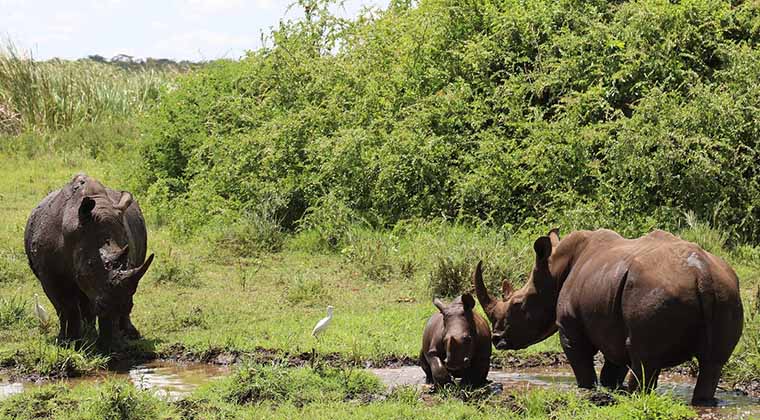
The increase in Rhino numbers is an important achievement, especially when rhinos remain under huge threat from poaching and habitat loss due to encroachment of their space by humans.
It was also reported that for the first time in 22 years, there was no Rhino which was recorded to have died in Kenya due to poaching. This was the first time since 1999, an incredible and significant milestone, considering that it was at a period when African wildlife had come under more threat because of the Covid 19 pandemic which caused the disappearance of virtually all income from tourism.
We applaud the government through the Kenya Wildlife Service and other Rhino conservators like the Ol Pejeta Conservancy and all wildlife rangers for their concerted efforts to safeguard Rhinos during that tough period, highly contributing to the recent increase in population.
Masai Mara and Serengeti Wildebeest Migration Update- October 2021
Our short report on how the wildebeest migration pattern between Serengeti and Masai Mara was like from May to September 2021
The migration of almost 2 million wildebeests, Zebras and Topis between the Serengeti and Masai Mara Eco system is without doubt the world’s most spectacular wildebeest spectacle. The highlights of this never-ending wildebeest journey are the annual calving season in the short grass plains of southern Serengeti between February and March and the mass movements and River crossings between Serengeti and Masai Mara from July to October.
This year, the wildebeest migration has lived up to its thrill once again.
The main motivation for the mass movement covering thousands of Kilometers is search for food and water. With scattered rains having fallen both on Serengeti and Masai Mara throughout the year, it means that there has been enough pasture in both parks. The wildebeests were therefore not in hurry to arrive in Masai Mara since there was adequate pasture in Serengeti.
From May, thousands of wildebeests could be sighted headed for Western Serengeti, from where they proceeded to the Grumeti, Fort Ikoma and Ikorongo areas before settling in Kogatende in northern Serengeti. From June, the scouts (mainly Zebras and small herds of Topis and Wildebeests) begun arriving in Masai Mara.
By mid-July, a good number of the migrant herds had already crossed over to Kenya. Big herds could be seen around the Sand River and central Masai Mara. Daily River Crossings were been recorded at the Looking Out Mara River Crossing points and the main crossing near Purrungat bridge as the marauding Gnus and Zebras made that dive of life or death heading towards the Mara Triangle or back to the main reserve.
On the other hand, big herds could still be sighted in Kogatende, northern Serengeti as they grazed or crossed the river several times, heading north or south. The ones that headed further north snaked their way to the amazingly beautiful Lamai Wedge where they spent several weeks grazing.
In early August, several big herds were congregated in central Masai Mara and predator vs prey action was in full swing as Lions and Cheetahs made daily kills. The famous Tano Bora Cheetah coalition (now 4 after they kicked one out of the group) could be seen by lucky tourists and guides as they made a kill every few hours. This was also reported among some Lion prides. By this time, Masai and northern Serengeti were full of wildebeest and Zebra carcass and Hyenas, Jackals and Vultures were having a field day enjoying plenty of food.
By mid-August, the wildebeests that had followed the Lamai Wedge route begin pushing further into the Mara Triangle. The most interesting part about this was that they went directly to the Triangle avowing the traditional route that would see them cross the Mara River inside the reserve. By end of August, the biggest part of the migrant herds was settled within the Mara Triangle with only a few scattered herds being reported in the main reserve.
Hundreds upon hundreds of thousands (probably up to a million) could be seen all the way from the Egyptian Goose dam extending all the way towards Baghdad Pond, Mara Serena Safari Lodge up to Kichwa Tembo road with views of congregated herds being witnessed right from the road side to kilometers far away, with the Oloololo escarpment in the horizon, forming the perfect background for captivating photo images.
The Masai Mara, currently enjoying unexpected rains and with its short grass plains full of juicy pasture, the herds that had made their way back towards Serengeti or even stayed there are being sighted headed back to Masai Mara as from late September. River crossings are being witnessed in northern Serengeti as several massive herds make a push towards the Masai Mara while others head the opposite direction into Serengeti.
It will be interesting to trail the migration and see how long they will stay in Masai Mara this year since the land of mottled plains is enjoying rains and has enough pasture, meaning that they might decide to stay until November, unless the Gnu instincts kick in and remind them that they need to rush and settle back in southern Serengeti on time for the calving season.
Stay tuned right here and on our FACEBOOK and INSTAGRAM pages for more updates from both the Serengeti and Masai Mara.
Feel free to contact us on: holidays@esseniasafaris.co.ke for a tailor made and privately guided Masai Mara and Serengeti Wildebeest Migration safari.
Advantages of a Low Season Safari to Kenya and Tanzania
Why is the Low Season the best time for a Kenya and Tanzania Safari?
Often, travelers who are planning a safari to Kenya and Tanzania find themselves wondering whether it would be worth it visiting during the low and green season months of April, May and November.
As professional safari experts for Kenya, Tanzania and Uganda, we give you advantages of booking a low season safari in order to help you to make an informed decision.
Talk of Lowest prices on accommodation and international & local flights, less crowded parks and lodges, and that rare opportunity to see the normally dry African Savannah turning ALL GREEN and teeming with life ..
These are just but some of the reasons why the low season months are the best for a Kenya and Tanzania safari.
Did you know that most special interest tourists like Professional Photographers,
Ornithologists, Wildlife Photographers and Researchers prefer the period between April and June for their visit to Kenya and Tanzania national parks and reserves?
The period between July and October is normally the busiest for Kenyan safaris.
This is not only because it coincides with the Summer when most people go on holiday, but also because of the rare wildlife spectacle of millions of wildebeest making that annual pilgrimage between the Serengeti and Masai Mara National Reserve. The same applies to Tanzania, which unlike Kenya is also very busy in January and March due to the wildebeest calving season in Ndutu, south of the Serengeti.
However, there is a rising number of both seasoned and first-time tourists who have discovered the secret in travelling during the green season. Kenya and Tanzania experience the long rains in April and May but this never degrades the ultimate safari experiences that East Africa is famous for in any way.
If anything, it only adds to the adventure and thrill of an Africa safari.
Contrary to common belief that most roads are impassable, driving is quite manageable especially if you are using a 4 x 4 WD safari land cruiser- the ultimate off-road beast. Those who do not prefer to drive can fly to most parks using Safari Link, Air Kenya, Governors Aviation or higher private charters in Kenya, while Regional Air, Air Excel, Coastal Aviation and Auric air are the leading safari airlines in Tanzania.
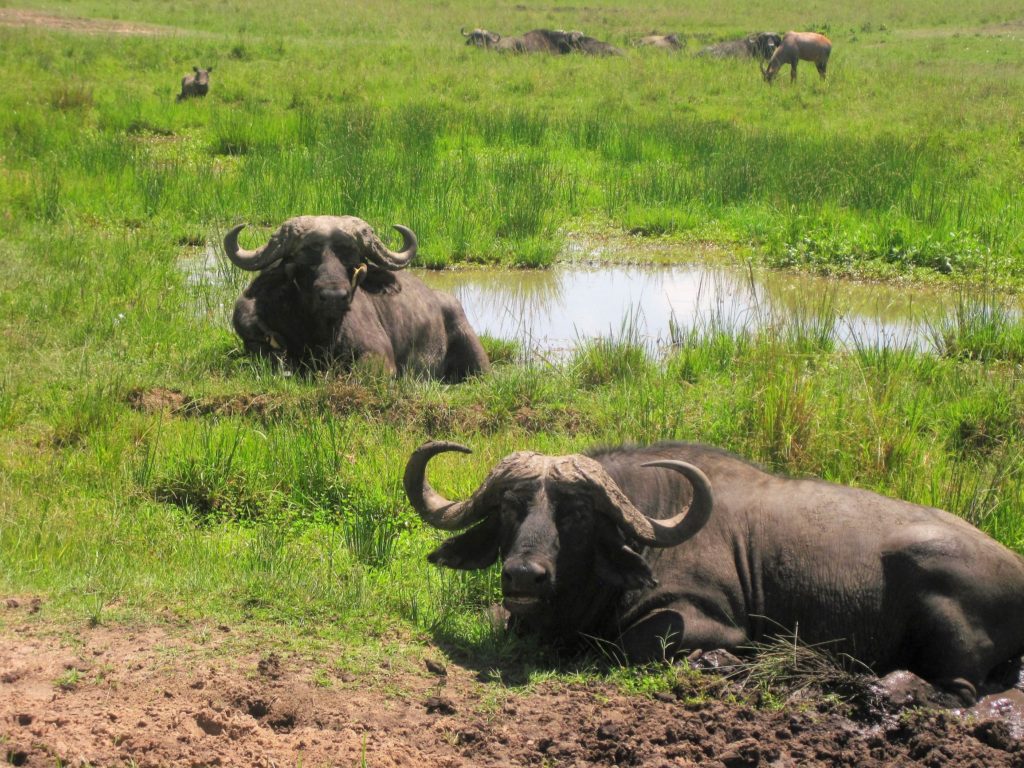
CHEAPER ACCOMODATION RATES:
While travelling during the low or green seasons, you benefit from highly discounted rates for your accommodation. This means that you can stay at some of Kenya and Tanzania’s popular safari camps and lodges at less than 50% of what you pay between July and October. You therefore save money, or have a higher budget to spend more nights on safari. Due to fewer tourists, this is also the time when you get highly personalized services and attention from the lodge staff. This must be one reason why most elderly tourists just love to be in East Africa during this season as they get that per minute attention that they rarely get back home or at any other destination.
UP CLOSE AND PERSONAL MOMENTS WITH AFRICAN WILDLIFE:
One of the most important aspects of an African safari is that authentic, wildlife safari experience, and it never gets eroded during this season, if anything, it gets even better.
Among the main reasons for wildlife movement is search for food, whether it is prey or greener pastures for grazing. After the dry spell that drives animals for miles in search of food, April brings the rains that replenish the vegetation, leading to less movements of herbivores as they have enough to feed on. The search for vegetation cover and privacy from human interference are other reasons that lead to wildlife movement. However, with the growth of vegetation, especially the tall grass and with only a few tourist vehicles in the parks, animals tend to stay very close to main park areas without much movement. This means that depending on the location of your lodge, you don’t have to drive for hours looking for wildlife during your game drives.
GREAT WILDLIFE PHOTOGRAPHY:
With less tourists in the parks, you get more time with the animals because most of the time, they will not move unless they are disturbed. A sleeping Lion, Cheetahs relaxing under a tree or a Leopard resting on a branch of an Acacia tree will remain calm and peaceful in the presence of only a few tourists, most likely your safari vehicle and one or two more being the only ones around a sighting during the low season. This offers you a great chance to take more photos from different angles, and to also shoot some wildlife videos.
It is not surprising to find a pride of lions, a Cheetah with cubs or a herd of buffaloes lying or feeding unperturbed, off a game driving track just a few meters to your lodge or camp.
Picture this, that moment during an afternoon game drive when your safari driver guide, after a long moment of silent search suddenly leads you up to a whole pride of Lions, probably 3 males, 6 females and over 8 playful cubs, both juvenile and infants, all lying by the roadside. As if that is not enough, the cubs amused by the arrival of a single safari vehicle will try to inspect it by scent and even walking across it from below, going around it for over 10 minutes before returning to their mothers and taking a pose for yet another photo? These are the imaginary moments that are more likely to come true during the low season when there is less human interference to the wildlife. Rare, pristine wilderness moments have happened in the past during this season, and it will be going down again this year, and in the years to come.
BEAUTIFUL LANDSCAPE:
Imagine that afternoon in mid-April when the sky darkens as towering thunder clouds brew up a storm that shuts out the sunlight and transforms the landscape into a brooding sweep of ink grey. A herd of Buffalos, 200 plus strong, march towards a sculpted Balanite tree – the desert date that looks like an Acacia with its flat-topped crown neatly trimmed below by Elephants and Giraffes.
The bright contrast between the light, dark grey clouds and the green vegetation offer you that perfect opportunity to capture awe inspiring sunrise or sunset images during the low season. Often, there will be some showers in the evening, followed by some sun and the rainbow making an appearance. If you are a photographer, we know you are already imagining the magical shots that you would be lucky to take if you were presented with such a scenario? That’s safari for you during the low season!
NEW BORNS AND THE CALVING SEASON:
The short grass plains of Ndutu in Tanzania’s Ngorongoro Conservation area and extending all the way to southern Serengeti are a bee hive of action between February and March. This is the time when the migrating wildebeests give birth en masse in what is known as the calving season. Wildebeest’s time their giving birth to coincide with long rains season which begins in end of March. This ensures that the newly born calves will find some soft and juicy sprouting grass to feed on. During a three-week window between late January and February, up to 8,000 calves will be born daily, with about 500,000 young ones being born by the time the synchronized birthing is over.
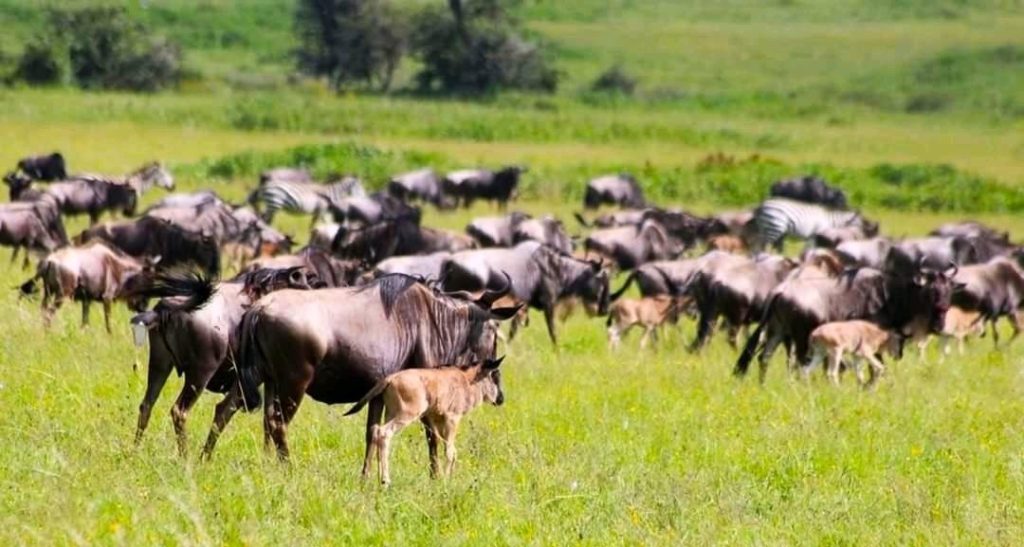
It has been observed that during the same period, Lions, Cheetahs, Hyenas, Serval Cats, Jackals and other predators also give birth. With so many Gnus being born at the same time, predators have an easy time providing milk and meals for their young ones since there is plenty of easy wildebeest kills. During this season, Elephants, Topis, Buffalos and other animals have also been spotted nursing their new borns.
The low season therefore offers you a great opportunity to see a lot of young predators and prey as they get introduced into the savage African wilderness. This is possible not just in Serengeti, but also in the Masai Mara, which is a northern extension of the former.
In Africa, rains are a blessing and not a curse and you probably don’t need much more evidence than what we have offered in this blog on why the low season is a great time for safari.
With our very affordable packages on offer, you now have every reason to visit Kenya and Tanzania in the months of April, May and November.
When it comes to delivering the ultimate African safari experience, you can then leave that to us and our team of highly experienced safari guides.
Feel free to contact us on: holidays@esseniasafaris.co.ke // +254 723 77 57 49 (whats app) for an expertly crafted safari package that suits your taste, budget and pace.
The Tano Bora- Masai Mara’s fascinating coalition of Five Cheetahs
It goes without saying that the Big Cats, (Lions, Leopards, and Cheetahs), are some of the biggest attractions that make Masai Mara one of the leading wildlife reserves in Africa, renown all over the world. Every game drive and every new visit to Masai Mara offers new sightings and a whole different game viewing experience.
Cheetahs are gentle and gracious cats. While on a game drive, they are mainly tolerant of human presence, and they love jumping over the safari jeeps in order to get a vantage point from where they can scan the plains for prey. Often, they will on a sunny day walk slowly closer and closer to the safari jeeps as you take photos or video, before finally lying under the car to protect themselves from the scorching sun.
A close encounter with Cheetahs will make you love them even more. They are skillful hunters who spend more time stalking their prey, so that they can spend less energy when making an ambush. Cheetah are the fastest mammals on land, capable of reaching speeds of up to 120km/h over short distances. The skillful cats can accelerate from 0 to 100 km/h in three seconds while on a hunting mission. While at full speed, the Cheetah can cover more than 7 meters in one stride and more than 25 meters in a second. This leaves their target prey with almost zero chance of escaping.
With a hunting success rate of about 58 %, the Cheetah is the best hunter if compared to Leopards at 38% and Lions at 30% (while hunting in pairs or a group). Although not gifted with a heavy built like Lions and Leopards, a Cheetah is intelligent enough to know when and where to hunt, where to live away from enemies, when to fight and when to walk away.
In the Masai Mara – Serengeti eco system, Cheetahs have been sighted abandoning their fresh killed prey to stay safe from Hyenas and Lions. Mother Cheetahs have however also been sighted standing up to bigger enemies like Lions who seek to kill their young ones.
A mother Cheetah protecting her cubs from a Lioness
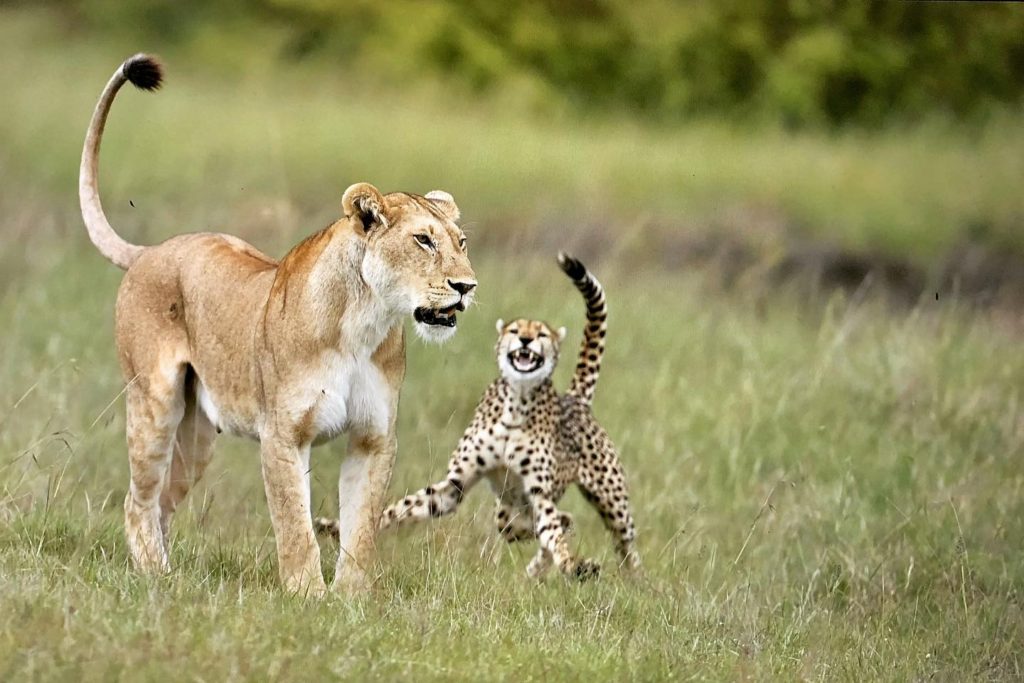
Cheetah sightings in Masai Mara had always been amazing. This was until early 2017 when a coalition of five male cheetahs emerged in the vast mottled plains. The experience became fascinating. The “Fast Five” or “Tano Bora” or “The Musketeers” as they are popularly referred to by safari guides have captured the hearts and lenses of so many Mara aficionados and turned the general perception about Cheetahs on its head.
UPDATE: OLPADAN, ONE OF THE TANO BORA COALITION MEMBERS AND FORMER LEADER OF THE GROUP WAS FOUND DEAD ON THE MORNING OF 26TH JANUARY 2022. HE HAD SERIOUS WOUNDS AROUND HIS BODY.
ALTHOUGH NO ONE WITNESSED HIS DEATH, IT IS BELIEVED THAT HIS FORMER COALITION PARTNERS WHO WERE ALSO SIGHTED IN THE AREA THE SAME MORNING HAD KILLED HIM DURING A FIERCE FIGHT. PLEASE SEE OUR STORY ON THE LINK ON THE FOLLOWING LINK:
UPDATE, 14th FEBRUARY 2022: On 13th February, Olarishani, a member of the Nne bora (form the original Tano Bora Cheetah coalition was discovered by guides lying down and in pain. He was seriously injured and vets were called to come and attend to him. Unfortunately, he succumbed to what appeared to be internal injuries. The four Cheetahs were crossing the Ol Talek River heading towards the Ol Kiombo side and it is suspected that Olarishani was attacked by a Crocodile, leaving him with life threatening injuries, which led to his death.
His coalition mates, Leboo and Winda were spotted calling out for Olonyok who was not with them. On 14th February, both of them have crossed back the Talek River from the Ol Kiombo side to Tipilikwani area and they seem to be seeking to reunite with Olonyok who is still not with them.
From tano bora, to nne bora and now the coalition is only three members, the tatu bora. Nature is really taking its course on this magnificent coalition.
The Tano Bora is not only the biggest known Cheetah coalition in the Mara, but also the first one recorded in recent years. The confidence, strength and skills that the Tano Bora exhibit during their escapades across the Mara has changed the assumptions that scientists had about Cheetah behavior.
To begin with, a coalition of 5 Cheetahs isn’t normal. Typically, a male Cheetah will upon reaching adulthood part ways with the mother to either become solitary, or join another male Cheetah to form a pair. This will help when it comes to taking down prey, and in guarding their territory.
The sighting of the 5 male cheetah coalition therefore attracted many wildlife lovers, including researchers who began to monitor this formidable coalition. Many actually thought that this would not last long.
Further follow up on these Cheetahs revealed that they are not brothers as some had assumed. Of the five musketeers, only two of them are believed to be of the same litter. No one knows about the other two, while it was also discovered that one of them is a lone ranger who is rumored to have come all the way from the Serengeti to join the group, despite having no family relations.
Oozing confidence that comes with the tyranny of numbers,
The Fast Five have turned the vast Masai Mara plains into a stomping ground for five odd years.
The marauding boys have become synonymous with thrilling hunts of prey that is bigger than themselves. During the wildebeest migration, they can take down more than one wildebeest within a day. They make killing a Topi look like a kid’s job. There is nothing as awe inspiring as catching all of the Fast Five in full-speed pursuit, or mid-kill committing their full bodyweight to bring an adult wildebeest down to the ground. In November 2020, the five were caught on camera bringing down an adult Zebra which they first had to separate from a dazzle of several others. This was the first time they were recorded on a Zebra hunt and the skills, speed and power that they exhibited made them look more like Lions than Cheetahs.
The Fast Five bringing down a Zebra
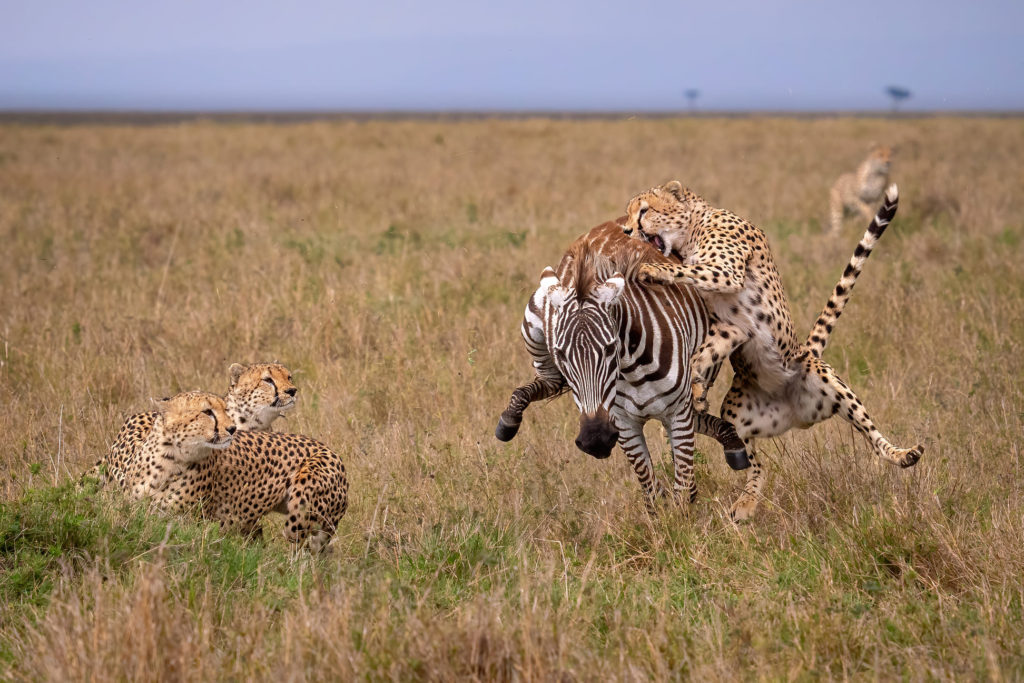
During their observation over the last 5 years in Masai Mara, researchers and guides have identified character traits that are unique to each of the five Cheetahs. This has led to each of them being given a name accordingly.
Olpadan had been identified as the coalition leader until recently. In the Maa language, his name means one with a great ability to shoot. Over the years, he has been noted to exhibit bullying tendencies. Olonyok, meaning the one who works hard to achieve better results in Maa language often the victim of Olpadan’s aggressiveness. This would often draw the attention of Olarishani, meaning the Judge in Maa language as besides being a skillful hunter, he is usually the peace maker in the coalition, often coming to the defense of any coalition mate when there are squabbles.
The fourth member is Leboo, meaning the one who always stays within a group. He is the one who is rarely spotted breaking away from the coalition, unlike the others who would occasionally desert the group for a few hours or days. The fifth member of the Fast Five coalition is Winda, meaning hunting in Kiswahili. True to his name, he is the one who mainly initiates many hunting attacks, and who displays more prowess in bringing down a prey.
Tano Bora taking down a Wildebeest
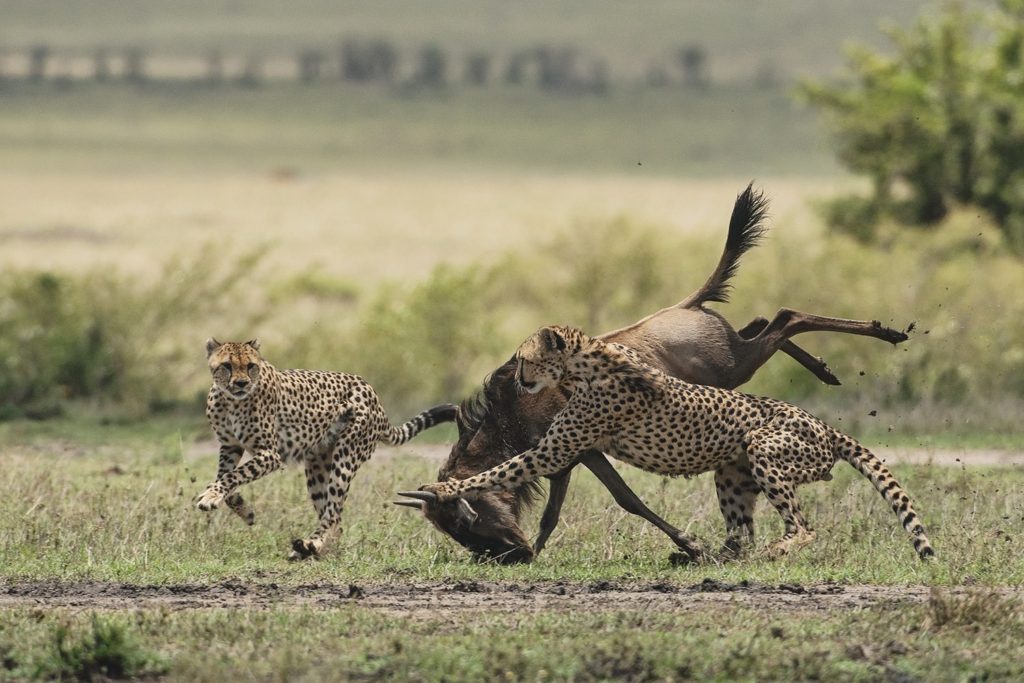
Lions are the ultimate social cats. They stay in prides that consist of Males, females, sub adults and cubs and have territories that they stay within. They will mainly hunt in pairs or in groups and have a social hierarchy, led by the dominant male. Often, they will be seen engaging in social bonding acts like licking of each other and fluffing of tails.
The same has been noted among the Tano Bora Cheetah coalition. You will see one cheetah or another periodically rousing itself, only to collapse into sleep next to another member of the coalition. This is a way of seeking physical contact with each other: an unmistakable hallmark of social bonding. They also exhibit social hierarchy under the leadership of Olpadan and Olarishani, who share the responsibilities of selecting the prey they will go for, mitigating internal conflict, and directing movement across their territory. The main advantage of Cheetahs being in a coalition is the fact that they help each other during hunting, and in protecting their territories. Throughout the Mara- Serengeti eco system, lone or pairs of Cheetahs have been seen to prefer going after Thomson Gazelles which are small in size, and sometimes warthogs and hares. But in big coalitions like the Tano Bora, they will often take down Wildebeests and even Zebras. While solitary Cheetahs and coalitions of two or three male Cheetahs are known to roam within a small territory, the Fast Five enjoy a big territorial range. They have been sighted far away from their main territory within the Tipilikwani area, going as far as past Keekorok and even crossing over the Talek River to spend some days at the Olare Motorogi Conservancy, outside the main reserve.
Wildlife enthusiasts hope that this coalition remains together long enough for more thrilling moments by photographers and for researchers to learn more about them, and Cheetah coalitions in general.
You are welcome to contact us for an expertly crafted and privately guided safari while enjoying a front row seat to encounter the Big Cats of Kenya and Tanzania. Contact us on: holidays@esseniasafaris.co.ke
Mobile and whats app: +254 723 77 57 49
Skype: Sam.Waweru3

